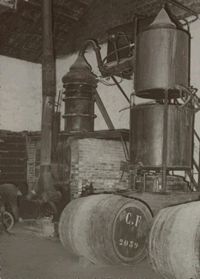Fractional Distillation
Fractional distillation is a modified version of the simple distillation technique which allows for the separation of a complex solution into its different components in a single distillation run by taking advantage of the difference in their boiling points.
A simple distillation is effective if you intend to isolate a volatile component (those that evaporate more readily at lower temperatures) from one that is not volatile in a solution, or if there is a marked difference in their boiling temperatures. When you distil an alcohol solution by means of a simple distillation the distillate obtained will have a higher concentration of alcohol but some water will also be present. You'll have to redistill this solution repeatedly in order to obtain higher concentrations of alcohol especially if you want to get into the 80% a/v range and above. Fractional distillation improves on that by effectively performing multiple distillations in a single run.

The fractionating column design exemplifies the fractional distillation process. In simple terms vapours from a boiling mixture rise up a column or fractionating tower and as the temperature along the height of the column decreases the less volatile elements condense on special perforated plates placed horizontally in the column a few centimetres apart. This may be considered as a single simple distillation run. As the vapours in the boiling mix continue to rise, these bubble up through the condensed liquid on the plates, enriching and reheating the condensate, initiating a second distillation. The rising vapours are also cleansed and purified as they come in contact with the condensate on the plates. The condensate or distillate may also overflow the plates sequentially from left to right creating a reflux stream of distillate which cool and purify the rising vapours. This process is described as rectification. Repeated condensation and evaporation of the vapours up the column on the plates results in greater concentrations of volatile components near the top of the column. Theoretically you can obtain 90% a/v with this design. The Armagnac Type Alembic Still, a professional continuous still is an example of this design.
The fractional design is for columns with wide diameters and is therefore not suited for the hobbyist.
An inexpensive alternative was devised in which these plates are substituted with packing such as copper mesh or ceramic objects and create the same effect as the plates in a fractional column allowing for condensation of the vapours on the packing itself and reflux of the distillate. This design is appropriately named as the reflux column and is incorporated into our Reflux Column Alembic Still. The height of the packing for the reflux column needed to do the same job as an ideal plate is known as HETP (Height Equivalent to Theoretical Plate.) The smaller your HETP the greater number of theoretical plates you can pack into a column and therefore the greater alcohol purity obtained.
Although perhaps not considered fractional distillation in the strictest sense, a multiple distillation process can be effected with our Rum Type Alembic Still. This design incorporates 2 smaller recipients where rectification of the rising vapours takes place before proceeding to the condensing recipient.
Fractional distilling revolutionized the petroleum industry. A fractionating or refining tower is used to draw off various petroleum products at different levels. So at the bottom bitumen type substances are drawn off, different fuels at higher levels and petroleum gases at the top. Liquid oxygen and nitrogen is also obtained through fractional distillation. For the hobbyist the best way to obtain almost colourless and flavourless high purity alcohol is the reflux column. You may use your pure vodka like distillate as a base for distilling herbs or fruits or for making liqueurs. Alternatively you may use it to produce your own high grade whiskey.

